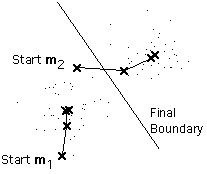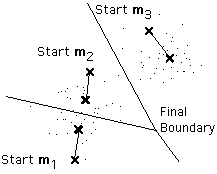The k-Means Procedure
Suppose that we have n example feature vectors x1,
x2, ..., xn all
from the same class, and we know that they fall into k compact clusters,
k < n. Let mi be the mean of the vectors
in Cluster i. If the clusters are well separated, we can use a minimum-distance
classifier to separate them. That is, we can say that x
is in Cluster i if || x - mi
|| is the minimum of all the k distances. This suggests the following procedure
for finding the k means:
- Make initial guesses for the means m1,
m2, ..., mk
- Until there are no changes in any mean
- Use the estimated means to classify the examples into clusters
- For i from 1 to k
- Replace mi with the mean of all of
the examples for Cluster i
- end_for
- end_until
Here is an example showing how the means m1
and m2 move into the centers of two clusters.

This is a simple version of the k-means procedure. It
can be viewed as a greedy algorithm for partitioning the n examples into
k clusters so as to minimize the sum of the squared distances to the cluster
centers. It does have some weaknesses.
- The way to initialize the means was not specified. One popular way
to start is to randomly choose k of the examples.
- The results produced depend on the initial values for the means, and
it frequently happens that suboptimal partitions are found. The standard
solution is to try a number of different starting points.
- It can happen that the set of examples closest to mi
is empty, so that mi cannot be updated. This
is an annoyance that must be handled in an implementation, but that we shall
ignore.
- The results depend on the metric used to measure || x
- mi ||. A popular solution is to normalize
each variable by its standard deviation, though this is not always desirable.
- The results depend on the value of k.
This last problem is particularly troublesome, since we often have no way
of knowing how many clusters exist. In the example shown above, the same
algorithm applied to the same data produces the following 3-means clustering.
Is it better or worse than the 2-means clustering? *
The answer can only be found by designing two different classifiers -- one
OR-ing together 2 subclasses and the other OR-ing together 3 subclasses
-- and seeing which performs better.

__________
* If it turns out to be better, why stop with k = 3 or k = 4 ? If we go
to the extreme of k = n, we wind up with what is called a nearest-neighbor
classifier. If the number of examples is large enough, a nearest-neighbor
classifier can perform excellently. However, it is computationally very
expensive. This brings up the point that, like all engineering problems,
classifier design is a compromise between price and performance.
 On to Fuzzy k-means
On to Fuzzy k-means
 Up to Clustering
Up to Clustering



![]() On to Fuzzy k-means
On to Fuzzy k-means
![]() Up to Clustering
Up to Clustering